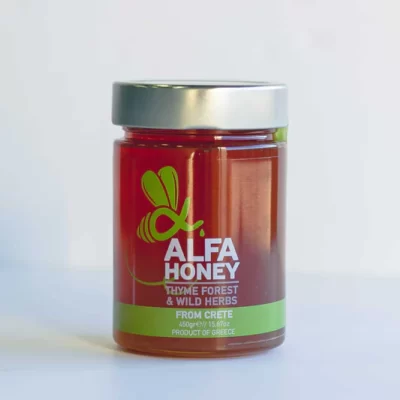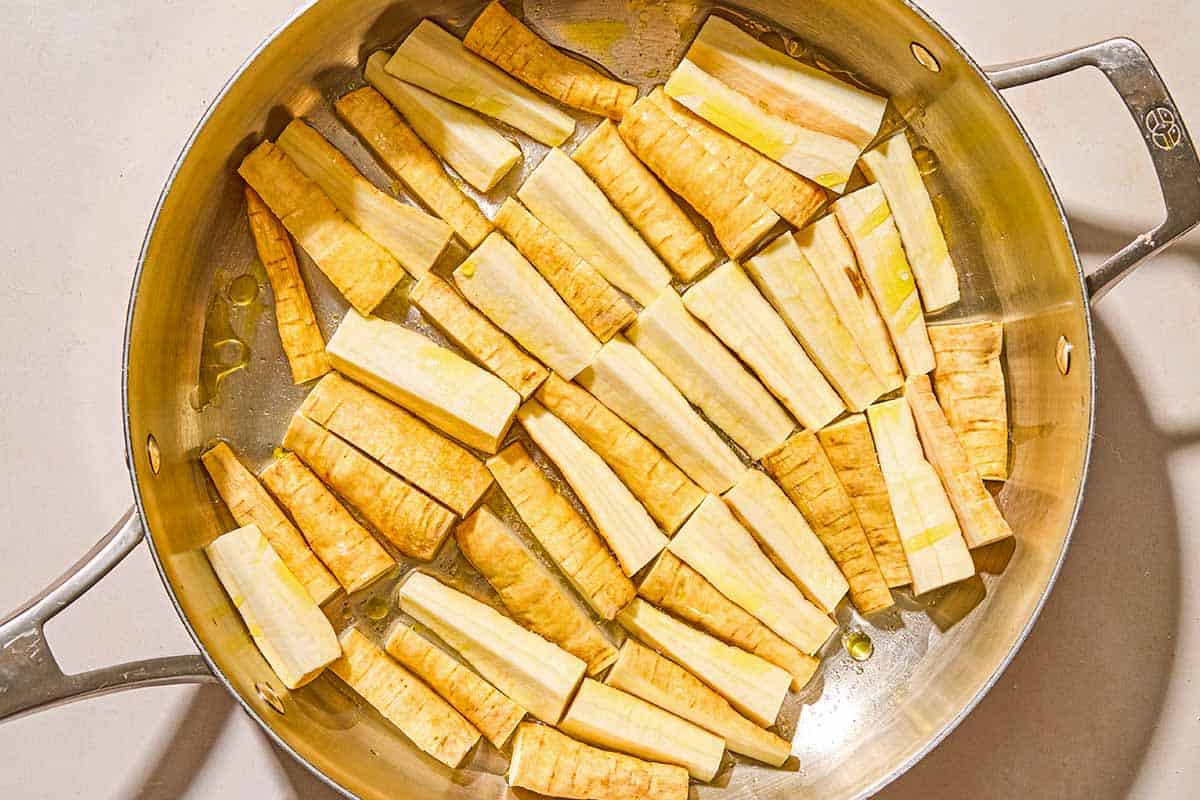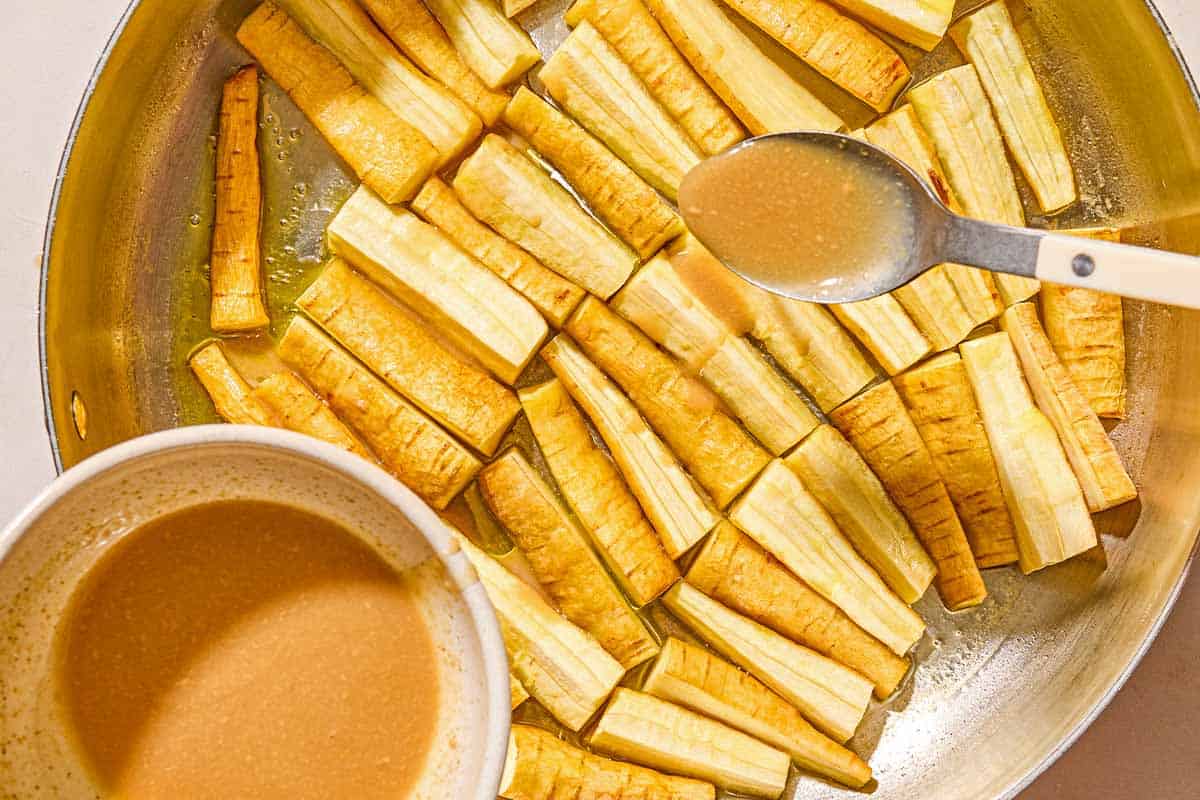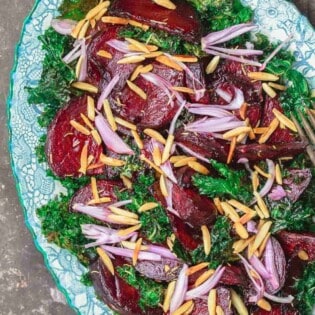Nutty parsnips become tender and beautifully bronzed when roasted with honey mustard glaze and finished with toasted hazelnuts in this simple side dish.
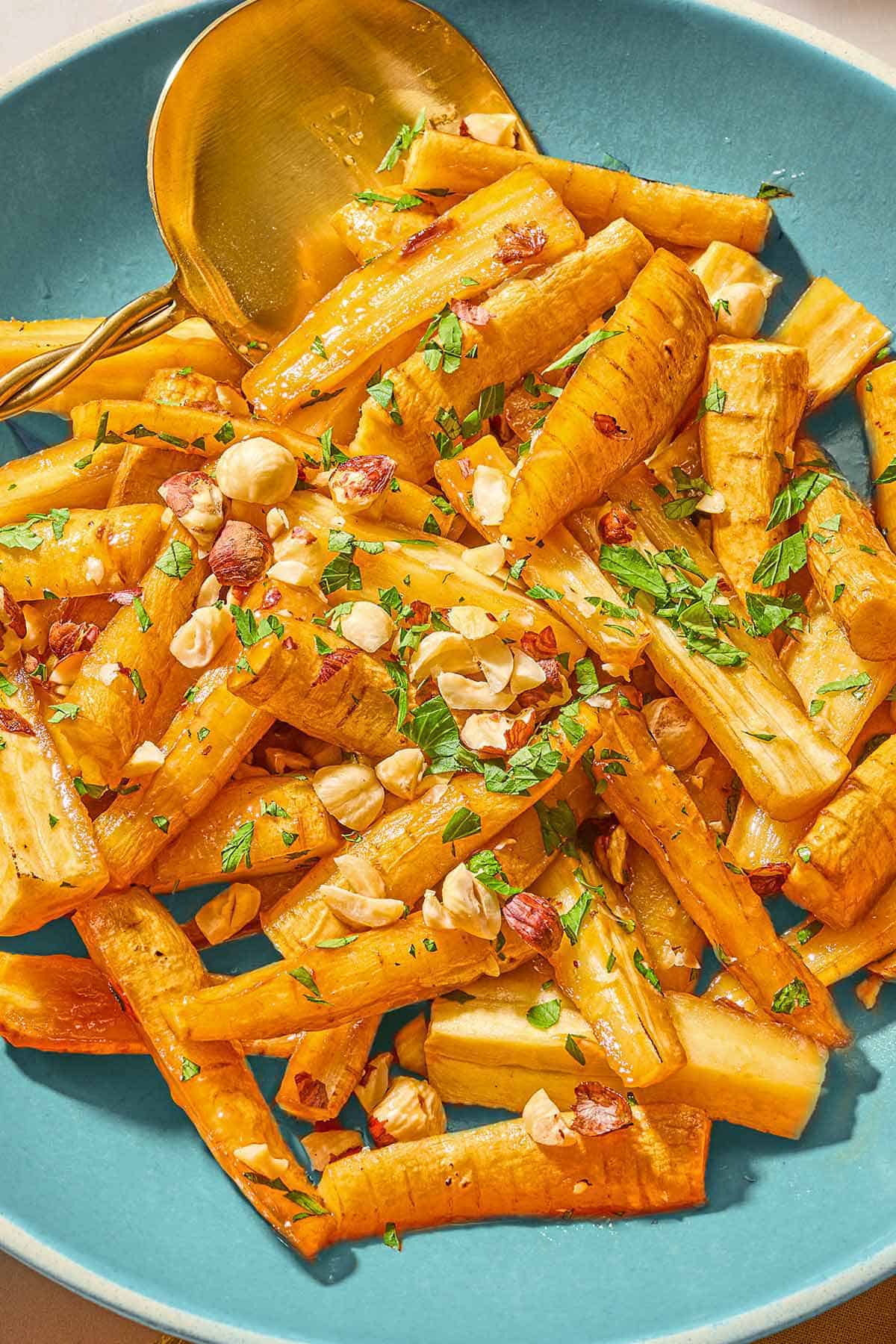
Parsnips are the underdog of the root vegetable world. They may look like beige carrots, but behind their mellow looks is a deep, nutty flavor with a hint of pepperiness (think parsley stems meets Yukon gold potatoes). They’re great steamed and mashed, pureed into soup, and deep fried in strips, but my favorite way with parsnips is to roast them.
Dry roasted parsnips tend to end up unpleasantly chewy and burnt in places because of their high starch content. That’s why some chefs insist upon parboiling parsnips before roasting.
I’ve devised a shortcut: simply add a little water to the pan, bring it to a simmer on the stove to jump start the cooking, and then transfer the pan to the oven to roast them.
To enhance their flavor and give them a beautiful burnished glaze, I add a mix of honey, Dijon mustard, and a little vinegar. This mixture coats the now tender batons and encourages them to caramelize—a little fresh Italian parsley and crunchy roasted hazelnuts finish the dish.
Roasted parsnips are easily one of my favorite cold-weather side dishes, a perfect accompaniment to turkey, chicken, or lamb.

Roasted Parsnips Ingredients
This recipe doubles down on the sweetness and nuttiness of parsnips with a sweet, savory honey dijon glaze. It’s a snap to throw together with items you’ve likely already got on hand. You’ll need:
- Parsnips: Size doesn’t predict whether parsnips will be tender or woody, that has more to do with when they were grown (cold weather is best) and how they are cooked. Shop for parsnips that are pudgy and wide throughout, pass on those with super long, skinny ends as they tend to be tough and fibrous.
- Extra virgin olive oil helps conduct heat and ensures the parsnips won’t stick.
- Salt enhances and lifts the flavor of this sweet taproot.
- Water helps soften the fibers of these roots and keeps the sugars from burning.
- Honey enhances the sweetness and caramelizes to an even glaze.
- Dijon mustard counters the sweetness and enhances the peppery flavors of parsnips.
- White wine vinegar brightens and lifts the flavors so the dish tastes balanced and vibrant
- Roasted hazelnuts amplify the nutty flavor of parsnips and add crunch
- Chopped Italian parsley adds an Instagram-friendly pop of color.
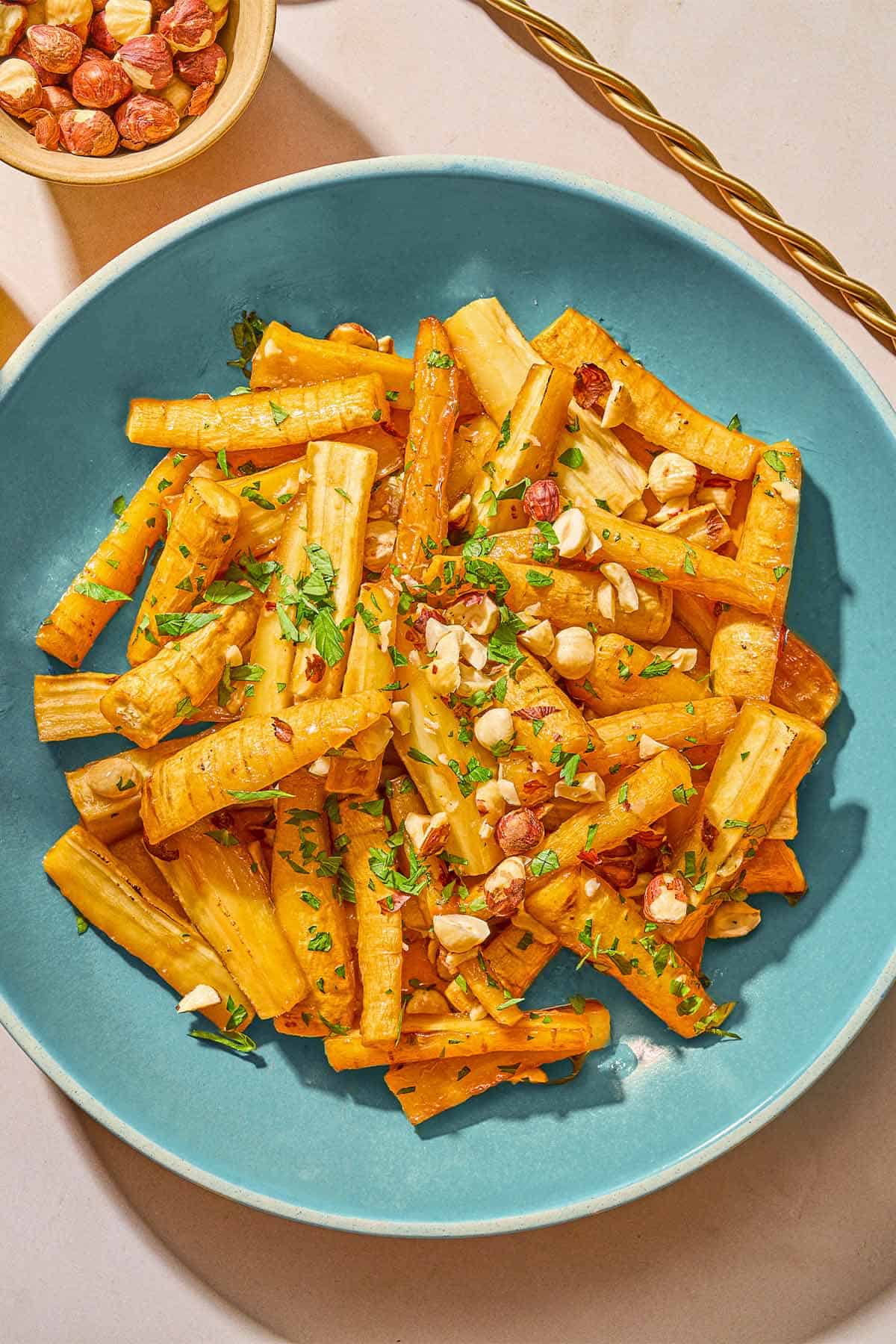
How To Make Roasted Parsnips
There are two steps to this recipe. First, you’ll start the parsnips simmering on the stove to jumpstart the cooking and soften the parsnips. Second, you’ll roast them in the oven, and finally, you’ll add a flavorful glaze that will help the roots caramelize. Here are the steps:
- Get ready. Preheat the oven to 400º F. Peel 1 1/2 pounds of parsnips. Divide the thick tops of the parsnips from the slender ends. Cut the thickest part lengthwise into halves or quarters (they should be about 1 inch wide at the thickest part). All the pieces should closely match in size.
- Simmer the parsnips. Put the parsnips in a large skillet or metal roasting pan large enough to contain the parsnips in an even layer. Add 2 tablespoons of olive oil and 1 teaspoon of salt and toss to combine. Arrange parsnips in a single layer and add the water. Bring to a simmer over high heat.
- Roast the parsnips. Roast, stirring occasionally, until fork tender, 20 to 30 minutes.
- Make the mustard glaze. Mix 1 tablespoon honey, 1 tablespoon Dijon mustard, and 1 tablespoon white wine vinegar. Pour over the parsnips and stir gently. Roast until the parsnips are browned in places, 10 to 15 minutes.
- Finish and serve. Sprinkle with 2 tablespoons chopped roasted hazelnuts and 1 tablespoon chopped parsley to garnish.
What are Parsnips?
Parsnips are a root vegetable with a uniform beige color that are typically wide at the top and taper to a more slender end than their cousin, the carrot.
- They are sweet and nutty tasting with a starchier texture than carrots, which means that while you can eat them raw, people generally cook them.
- Parsnips are in season in spring, fall, and winter due to different growing methods. For me, the most flavorful parsnips have spent several months in the ground in late fall or winter.
- Parsnips are high in fiber. Just 1 cup will give you 26% of your daily recommended fiber. They’re also full of antioxidants, folate, and Vitamins C and K.
Make it Your Own
This recipe is super flexible, feel free to mix it up with the glaze ingredients, the herbs, and the garnishes.
- Substitute maple syrup for honey
- Substitute lemon juice for the vinegar
- Change up the nuts: roasted cashews, almonds, or pecans are all delicious with this dish.
- Get creative with the herbs: Swap the parsley for whatever fresh, tender herbs you have on hand. Chives, green onions, basil, and dill are all good partners with parsnips.
What To Serve With Roasted Parsnips
I love to serve this recipe at Thanksgiving in lieu of roasted carrots because the peppery flavor of parsnips pairs so nicely with roasted poultry like Lemon Roasted Turkey. They’re also great with a more casual meal of Easy Oven Roasted Chicken.
In England, parsnips are a traditional side dish for roast beef or lamb. Try them with our Best Beef Tenderloin or Mediterranean Roasted Leg of Lamb. I also think they pair well with “the other white meat.” Try them alongside our Stuffed Pork Tenderloin or these Pork Chops with Bay Leaf and Lemon.
More Roasted Root Vegetables
Sides and Small Plates
Roasted Carrots with Sumac and Lemon Zest
Sides and Small Plates
Roasted Radishes
Mediterranean Diet Recipes
Roasted Beet Salad with Crispy Kale and Almonds
Sides and Small Plates
Roasted Rainbow Carrots with Dukkah, Garlicky Yogurt and Mint
Browse all Mediterranean recipes.
Visit Our Shop.
Honey Mustard Roasted Parsnips with Hazelnuts

Ingredients
- 1 1/2 pounds parsnips, peeled and trimmed
- 2 tablespoons extra virgin olive oil
- 1 teaspoon salt
- 1/2 cup warm water
- 1 tablespoon honey
- 1 tablespoon Dijon mustard
- 1 tablespoon apple cider or white wine vinegar
- 2 tablespoons chopped roasted hazelnuts (see note)
- 1 tablespoon finely chopped parsley
Instructions
- Get ready. Preheat the oven to 400ºF. Divide the thick top of the parsnips from the slender ends. Cut the thickest part lengthwise into halves or quarters (they should be about 1 inch wide at the thickest part). All the pieces should closely match in size.
- Simmer the parsnips. Put the parsnips in a large skillet or metal roasting pan large enough to contain the parsnips in an even layer. Add the oil and salt and toss to combine. Arrange parsnips in a single layer and add the water. Bring to a simmer over high heat.
- Roast the parsnips. Transfer the skillet or roasting pan to the oven and roast, stirring once, until the parsnips are fork-tender, 20 to 30 minutes. The water will have nearly evaporated.
- Make the mustard glaze. Mix the honey, mustard, and vinegar in a small bowl. Add to the parsnips, stir gently making sure not to break up the parsnips, and roast until deep brown and glazed, 10 to 15 minutes.
- Finish and serve. Transfer the parsnips to a serving bowl and garnish with the parsley and nuts. Serve immediately.
Notes
- Shop this recipe: Visit our shop to browse quality Mediterranean ingredients, including the olive oil and honey used in this recipe.
- To roast hazelnuts: Place raw hazelnuts on a small rimmed baking sheet and bake in a 325ºF oven until the dark skins have cracked and the nuts smell buttery, 15 to 20 minutes. Rub the warm nuts in a dish towel to remove the papery skins.
- How to select parsnips: Choose squat, wide parsnips that are fairly uniform in width throughout for the most even cooking. Pass on parsnips with very long spindly tips.
Nutrition
Try Our Authentic Greek Honey!
This award-winning honey from the Fragiadakis family in Crete is sustainably harvested from the island’s biodiverse mountains, where bees feast on wild aromatic herbs.
